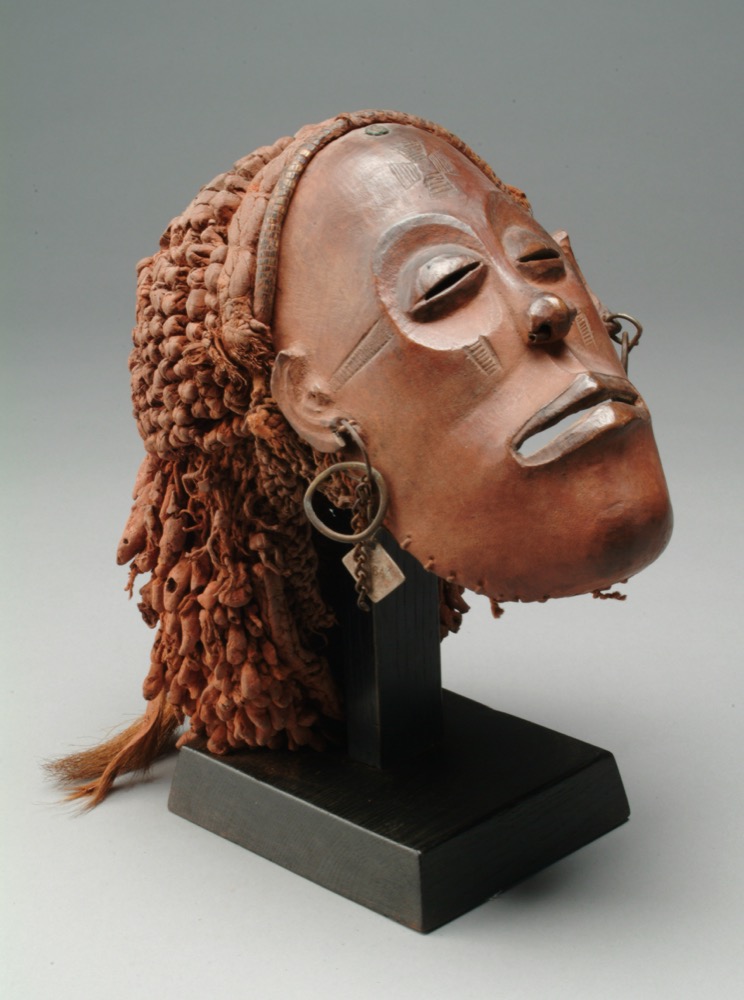 The mask’s biography encompasses three continents, more than 100 years, and dozens of prominent individuals.
The mask’s biography encompasses three continents, more than 100 years, and dozens of prominent individuals.
In its original context, the wooden mask was one small part of an elaborate costume and performance. Most likely carved near the end of the nineteenth century, it represents a woman (pwo in the Chokwe language). This type of mask was found in many neighboring communities across Angola, the Democratic Republic of the Congo, and Zambia, including those of the Chokwe, Lunda, Luvale/Lwena, Luchazi, and Mbunda peoples.
“African artworks that are on display in the U.S. have, by definition, experienced a long journey before arriving here,” says Laura De Becker, UMMA’s Helmut and Candis Stern Associate Curator of African Art. “What makes this particular mask unique is that we have been able to trace a significant part of its journey, including the names of the precise people who were involved – who held, traded, made, and cherished this exquisite mask.”
UMMA’s mask was taken from its original context in 1905 by Leo Frobenius (1873–1938), a German explorer who visited the Chokwe region during a two-year expedition into Central Africa. Frobenius returned to Germany with 8,000 objects, which he sold to museums and dealers in order to fund his subsequent Africa expeditions.
The mask was then acquired by the well-known German dealer J.F.G. Umlauff, whose shop in Hamburg provided many European and American museums with their early collections of African art. At the time, African art was underrated in the field of art history and Umlauff was a visionary in recognizing the value of these pieces.
From Hamburg, through the hands of the Belgian dealer Marc Leo Felix, the mask was sold to Helmut Stern, the businessman and philanthropist based in Ann Arbor. A passionate art collector, Helmut and his wife Candis Stern compiled an exquisite collection of Central African art, which they donated to the Museum in 2005, alongside an endowed curatorship of African art.
“The age, quality and provenance of this work truly make it a highlight of our collection,” De Becker says. “It is rare to find a mask that is this well-preserved and this well-documented. Especially its red color, which was achieved through the application of camwood powder, is still very vibrant for a piece that is over 100 years old.”
Its past travels speak to histories of trade and interaction, but also of colonialism and oppression. Through a selection of related artworks, photographs, and historical documents, the exhibition traces the biography of the mask and by doing so seeks to acknowledge the layers of meaning that potentially accompany every piece in the Museum’s collection, and its African artworks in particular.
Image: Artist unrecorded, Chokwe peoples, Angola, the Democratic Republic of the Congo and Zambia. Pwo (woman) mask, ca. 1890, wood, tukula powder, clay, string, metal, fur, snakeskin, cloth, chicken foot, tax token, button. University of Michigan Museum of Art, Gift of Candis and Helmut Stern, 2005/1.201
Upcoming Exhibition Programs
Gallery Talks and Tours: Traces: Reconstructing the History of a Chokwe Mask
Sunday, Oct. 30 - 2-3 p.m.
Gallery Talks and Tours: Traces: Reconstructing the History of a Chokwe Mask
Sunday, Nov. 27 - 2-3 p.m.
Curator Lecture: Traces and Fragments: the Life of a Chokwe Mask
Wednesday, Dec. 7 - 5:30–7 p.m.
